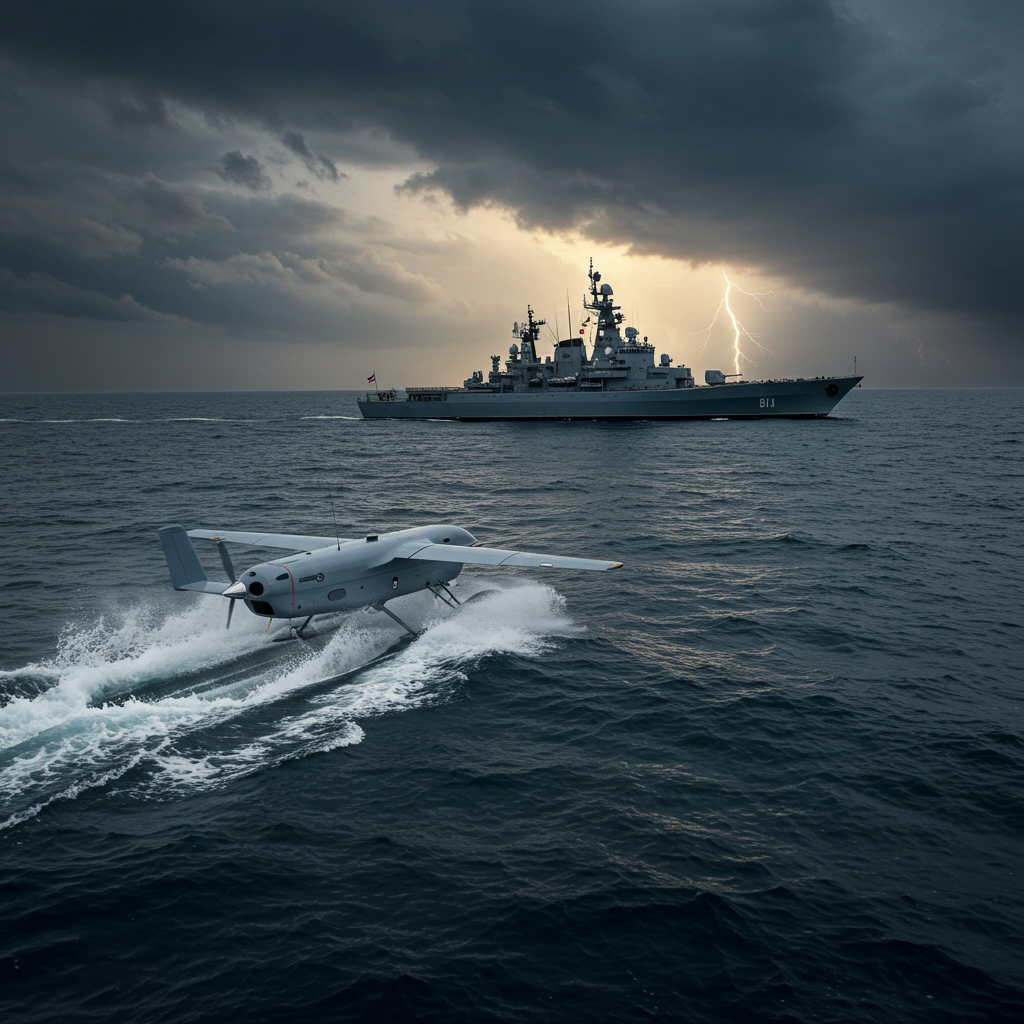Ukraine’s innovative use of maritime uncrewed systems, often referred to as naval drones, is fundamentally altering the landscape of black Sea warfare. Faced with a significantly larger Russian fleet but lacking traditional naval assets, Ukraine has turned to asymmetrical, cost-effective solutions. These unmanned vessels, deployed with increasing sophistication, are posing substantial threats to Russian naval operations, forcing the Black Sea Fleet to adapt its tactics and expend valuable resources on countermeasures.
Ukraine’s Ingenious Naval Strategy
Deprived of a conventional navy after 2014, Ukraine embraced necessity as the mother of invention. The development and deployment of naval drones, or maritime uncrewed systems (MUS), became a cornerstone of its defense strategy at sea. These systems are not just simple remote-controlled boats; they are rapidly evolving platforms equipped with advanced technology.
Initial designs proved their potential as explosive-laden kamikaze craft capable of striking Russian vessels and infrastructure. While significantly cheaper than warships, these drones offer a way for the weaker force to challenge a dominant adversary using “guerrilla tactics” at sea. Their success has demonstrated that tactical innovation can yield strategic results.
Breakthrough Capabilities Emerge
Recent developments in Ukraine’s naval drone programs, particularly those reported in early 2025, showcase a significant leap in capability. New types of unmanned surface vessels (USVs) fielded by Ukraine’s Main Intelligence Directorate (GUR) are redefining expectations. These platforms are integrating advanced features previously unseen on the battlefield.
Equipped with Starlink satellite internet antennas, they ensure reliable, high-speed communication far from shore. A truly unprecedented capability revealed is the integration of systems to launch other drones, enabling multi-domain operations from a single naval platform. Some drones are designed to carry significant payloads of various weapon types or house containers specifically for deploying first-person view (FPV) kamikaze drones.
Drones That Fight Air Threats
Perhaps the most revolutionary development, hinted at in recent reports, is the potential for these naval drones to carry and employ missiles. Specific accounts describe Ukrainian drones being equipped with missile launchers and even laser guidance systems. A notable incident in February 2025 reportedly involved a Ukrainian drone equipped with air-to-air missiles successfully shooting down a Russian Su-30 fighter jet over the Black Sea. This demonstrates an entirely new dimension of naval drone warfare, allowing unmanned surface vessels to potentially provide limited air defense cover or engage low-flying threats, complicating Russia’s air operations over the sea.
These advancements leverage commercial technology and integrate “NATO-style artificial intelligence” for targeting and operational versatility. The Sea Baby, developed by Ukraine’s SBU, is another example of these innovative, radar-resistant USVs, costing around $221,000 per unit but capable of inflicting significant damage.
Operational Impact on the Russian Fleet
The tactical successes achieved by Ukraine’s Black Sea drones have translated into considerable operational effects on the Russian Black Sea Fleet. While vulnerable to countermeasures if detected, particularly simple defenses like machine guns, skilled operation often involves complex tactics. Launching multiple USVs in packs, often supported by a reconnaissance drone for targeting, is a common strategy to overwhelm defenses and increase the chance of a successful strike.
Ukraine has successfully damaged or sunk numerous Russian vessels using these methods. Notable successes include hitting landing ships like the Olenegorsky Gornyak and tankers like the Sig. More significantly, Ukrainian naval drones have been credited with sinking high-tonnage vessels such as the corvette Ivanovets and the landing ships Novocherkassk and Tsezar Kunikov.
Forcing Fleet Relocation
These persistent threats have directly impacted the Russian Navy’s behavior. One of the most significant operational consequences has been the forced relocation of a substantial portion of the Black Sea Fleet. Vessels have moved from their primary base in Sevastopol, Crimea, which is highly vulnerable to maritime uncrewed systems, to seemingly less secure ports like Novorossiysk in Russia and potentially even facilities in occupied Abkhazia.
This relocation disrupts Russian logistics, complicates command and control, and reduces the fleet’s ability to project power and enforce sea control effectively in the western Black Sea. The cost of maintaining operations from less suitable or more distant bases adds to Russia’s overall burden.
The Cost of Countering Novel Threats
The strategic challenge posed by Ukrainian naval drones forces Russia to expend considerable resources. While the original claim suggesting drones with anti-air missiles specifically force the expenditure of anti-ship missiles isn’t explicitly detailed in the external summaries, the overall picture shows Russia must deploy a wide array of costly countermeasures.
Russia is adapting to this asymmetric threat. This requires investing in and deploying various defensive systems, from electronic warfare capabilities to jam drone signals (though Ukraine is developing anti-jamming tech like Artemis) to utilizing conventional weaponry. Countering swarms of fast, maneuverable, and potentially radar-resistant USVs demands constant vigilance and the use of diverse assets. While simple defenses can work up close, detecting and engaging these drones at range or preventing mass attacks necessitate more sophisticated and expensive solutions, potentially including patrol vessels, helicopters, and defensive missile systems. The very act of constantly adapting defenses and relocating high-value assets represents a significant and ongoing expenditure for the Russian military.
Challenges Remain
Despite their impact, Black Sea drones face limitations. Their cost, while less than traditional warships, is still substantial enough to hinder rapid mass production by decentralized initiatives compared to smaller FPV land drones. Targeting remains more challenging at sea due to a lack of static landmarks, requiring sophisticated intelligence support potentially involving satellites and other sensors. Their operational range is limited, preventing long-term stationing or widespread area denial far from friendly shores. Moreover, Russia is continuously evolving its defenses, leading to an ongoing technological arms race in the Black Sea.
Ultimately, maritime uncrewed systems serve as a potent tactical and operational tool for Ukraine. They have secured vital gains, such as helping to reopen critical export routes and denying Russia uncontested access to key coastal areas. While they may not replace the strategic power of a traditional navy, their innovative use buys Ukraine valuable time and forces Russia into a costly defensive posture, highlighting the evolving nature of modern naval conflict.
Frequently Asked Questions
What are the most advanced capabilities of Ukraine’s naval drones?
Ukraine’s latest naval drones boast several advanced features. They use Starlink for reliable communication and can launch other kamikaze or strike drones from the sea. Critically, some new models have been reported to carry missile launchers, with one notable instance describing a drone equipped with air-to-air missiles successfully shooting down a Russian fighter jet, adding a new dimension to naval warfare.
How have these drones impacted the Russian Black Sea Fleet’s operations?
The tactical successes of Ukrainian naval drones have significantly impacted the Russian Black Sea Fleet. Persistent attacks have forced the fleet to relocate many vessels from their primary base in Sevastopol, Crimea, to potentially less secure ports like Novorossiysk and Abkhazia. This disrupts logistics, complicates movements, and reduces Russia’s ability to maintain control over key Black Sea areas, aiding Ukraine’s defense and export efforts.
What makes Ukraine’s naval drones challenging for Russia to counter effectively?
Ukraine’s naval drones present a challenge due to their cost-effectiveness relative to the assets they threaten, their use in coordinated swarm tactics to overwhelm defenses, and technological features like high speed, maneuverability, and materials resistant to radar detection (as seen with the Sea Baby). Integration of technologies like Starlink enhances their range and resilience, while ongoing Ukrainian efforts like Project Artemis aim to counter Russian electronic warfare jamming.
Word Count Check: ~1100 words




